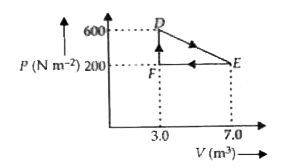Ramu is rolling a gas cylinder from A to C though B as shown in the adjoining figure by applying a force of 100 N . Calculate the total work done by him .

700 J
400 J
500 J
300 J
The correct Answer is:A
Initial displacement of the body, AB = 3 m
Subsequent displacement of the body, BC = 4 m
Force applied, F = 100 N
Work done,
W=F×(AB+BC)=100×(3+4)=700 J
Hence, the correct option is (a).
Similar Questions
A man carries a suitcase on head by applying a force of 20 N . He travels a horizontal a distance of 10 m and then climbs a vertical distance of 5 m . Calculate the total work done by him .
View SolutionA chain (mass M) is hanging from a wooden structure as shown in the figure A. It is slowly taken to a state as shown in the figure B. Calculate the work done by gravity in the process (assume that after reaching the ground, the chain does not form a heap)

View Solution
Knowledge Check
Ramu is rolling a gas cylinder from A to C though B as shown in the adjoining figure by applying a force of 100 N . Calculate the total work done by him .
 A700 JB400 JC500 JD300 J
A700 JB400 JC500 JD300 JA thermodynamics process is carried out from an original state D to an intermediate state E by the linear process shown in figure, the total work is done by the gas from D to E to F is
 A100 JB450 JC300 JD250 J
A100 JB450 JC300 JD250 JStarting from rest a 10 kg object is acted upon by only one force as indicated in figure. Then the total work done by the force in 5 seconds is
 A90 JB320 JC245 JD490 J
A90 JB320 JC245 JD490 J
A block of mass 30 kg is pulled up by a rope as shown in Fig. with a constant speed by applying a force of 200 N parallel to the slope. A and B are initial and the final positions of the block. Calculate:
(a) the work done by the force in moving the block A to B,
(b) the potential energy gained by the block,
(c) account for the difference in work done the force and the increase in potential energy of the block.

View SolutionA particle of mass m=1kg is moving in space in X direction with a velocity of 10ms−1. A 4 N force acting in Y direction is applied on it for a time interval of 5.0s. Later a 5 N force was applied on it in Z direction for 4.0s
(a) Calculate the total work done by both the forces.
(b) Which force performed greater work ?
View SolutionA perosn is holding a bucket by applying a force of 20N. He moves a horizontal distance of 15m first and then climbs up a distance of 12m. What is the total work done by him?
View SolutionA body of mass 2 kg initially at rest moves under the action of an applied horizontal force of 7N on a table with coefficient of kinetic friction =0.1. Calculate the
(a) work done by applied force in 10s. (b) work done by friction in 10s.
(c ) work done by the net force on the body in 10s.
(d) change in K.E. of body in 10s, and interpret your result.
View SolutionIn the shown figure curve 1 represents an adiabat for n moles of an ideal mono atomic gas. Curve 2 and 3 are two isotherms for the same sample of the gas. Calculate the ratio of work done by the gas in doubling its volume from V to 2V along the isotherms 2 and 3.

View Solution
